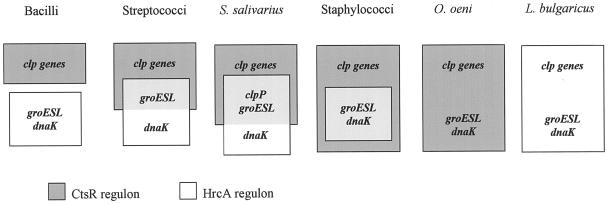FIG. 5.
Dual regulation by CtsR and HrcA in different gram-positive bacteria. In many gram-positive bacteria, the CtsR and the HrcA regulons coexist. In B. subtilis and closely related bacilli (B. anthracis, B. stearothermophilus, B. halodurans, C. acetobutylicum, C. difficile, C. perfringens, L. monocytogenes, and L. innocua), the two regulons are distinct, whereas in the streptococcal group (S. pneumoniae, L. lactis, and S. salivarius), they partially overlap, and the HrcA regulon is entirely embedded within the CtsR regulon in S. aureus. O. oeni and L. bulgaricus have original heat shock gene regulation with a predominant control of molecular chaperone genes by either CtsR or HrcA, respectively (adapted from Chastanet et al. [11]).

